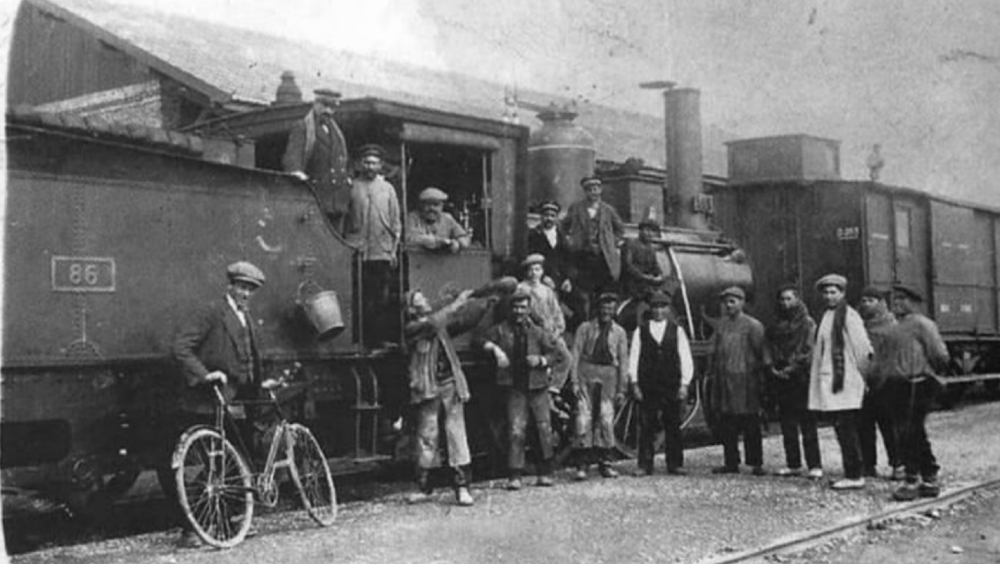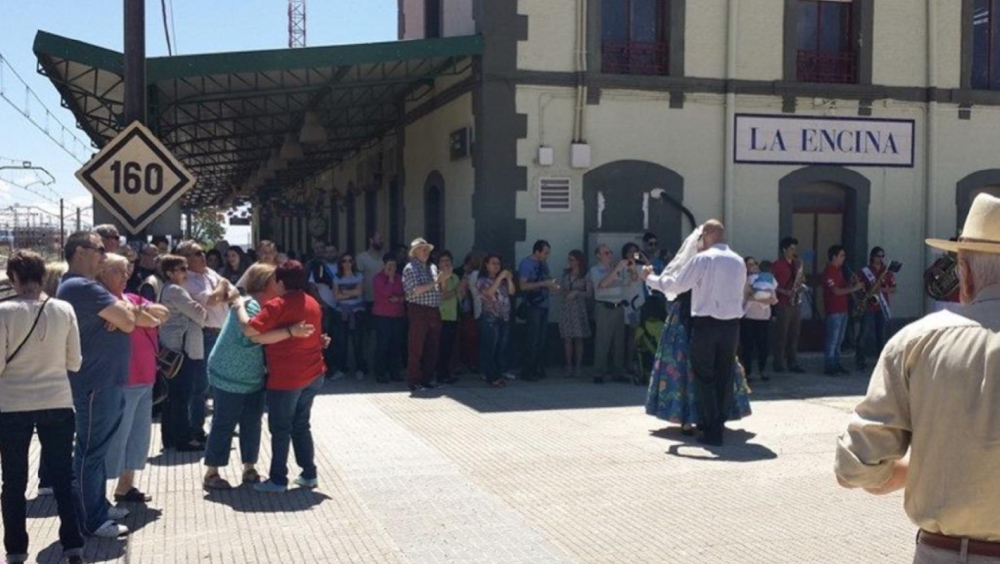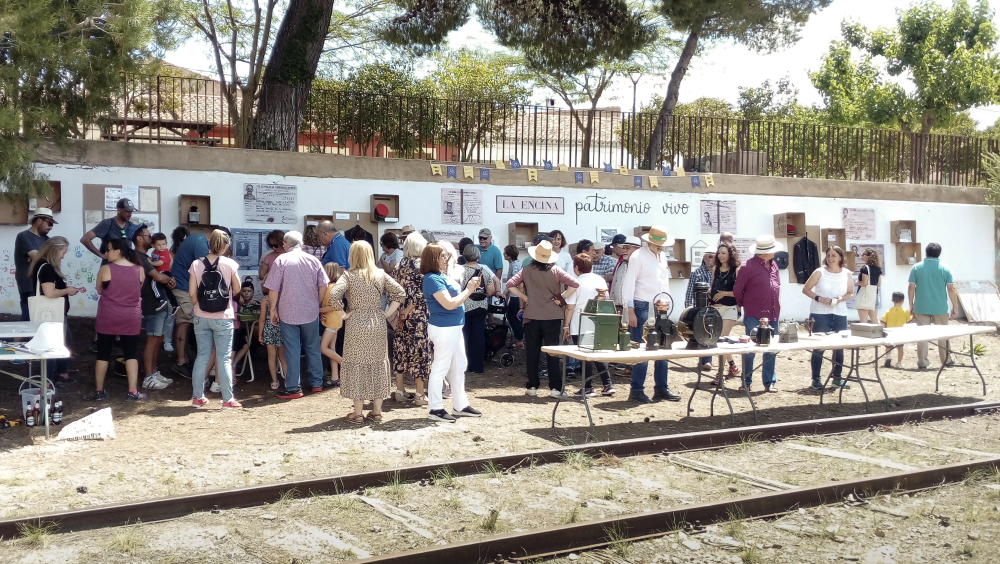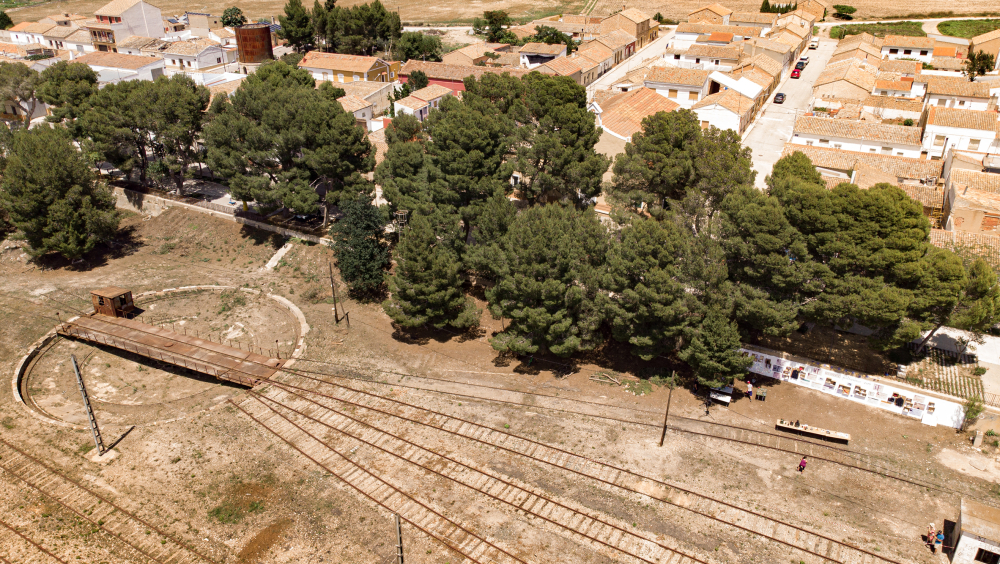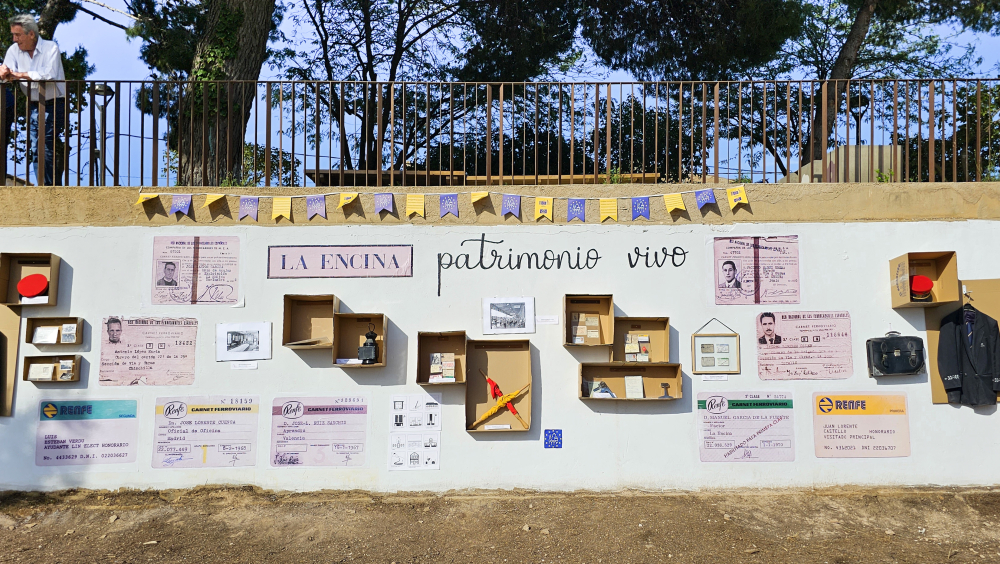The Echo of Steam
La Encina was born with the whistle of a train. In a place where there were no houses, no squares, no roads—just tracks crossing each other and a solitary building where the first railway workers from the two operating companies began to build not just a station, but an entire community. Over time, the steady flow of travelers and workers, along with the thunder of metal, gave shape to a whole town, where every house seemed to beat in sync with the locomotives.
The golden years brought bustling platforms filled with passengers, workers whose hands were hardened by coal, a tavern always crowded with hungry travelers, trains arriving and departing endlessly and, of course, the laughter of children who grew up with the echo of the railway as their lullaby. These were prosperous times that solidified the town’s structure, always centered around the railroad. But as the years passed, modernization, with its cold efficiency, reduced La Encina to a ghost station where only a few trains stopped.
The railway workers of old grew old themselves, watching their town fade away like the smoke from the old locomotives. But their memories, etched into every railway tie and every brick of the station, still vibrated in the air. They told their grandchildren stories of La Encina, showed them photographs that recalled their work from years past, and carefully preserved their uniforms and tools. And so, the children and grandchildren of those men and women decided that the past could not be forgotten. If the train had been the soul of La Encina, they had to find a way to keep that soul alive.
La Encina, Today
Nowadays, the community of La Encina continues to consider railway heritage an essential part of its identity. But sadly, this heritage now stands at risk. Yet, the residents, bearing witness to the town's gradual decline, remain resolute in their efforts to safeguard, conserve, and celebrate this invaluable legacy. Beyond its intrinsic heritage value, the railway holds profound sentimental significance for the community, spurring them to action in its preservation.
Determined to keep the memory of La Encina alive and the spirit of the life that once revolved around the railroad, the population continues to work together to ensure that their history is not forgotten. They have engaged in dissemination, conservation, and even musealization efforts while sharing the stories of those golden days with future generations.
Today, more than 160 years after the first rails and sleepers were laid in La Encina, the town still stands as a living witness to what it once was. Although trains no longer stop with the same frequency and modern life has transformed the town’s appearance, the spirit of the railroad still beats in every corner of La Encina. It is felt within homes, along the sculptural promenade that runs through it, or in the summer conversations held on the doorsteps of houses, reminding everyone that although time moves forward, the past should never be forgotten. In La Encina, the history of the railroad remains the backbone of the community, and efforts continue to keep alive the memory of the ties that unite its inhabitants and the importance of preserving its material and immaterial heritage, which constitutes the essence of the town.
Over the years, several dissemination and promotion activities have been carried out, with And now what? standing out. This 2021 project, conducted with children and young people, was awarded the European Heritage Makers Prize for its creative and sustainable approach to defending local heritage. Additionally, the community has organized European Heritage Days (EHD) events, the most recent of which took place in 2023. This event highlighted the importance of railway heritage as Living Heritage, emphasizing its profound significance in the community’s identity and reinforcing the crucial role of citizen participation in its preservation.
A Plan for the Future
As in all stories, the inhabitants of La Encina wanted a happy ending for theirs—one that would ensure their history remained alive for future generations. To achieve this, they did not sit idly by; instead, they devised a plan that could directly contribute to the conservation and dissemination of their heritage, as well as to local development.
The plan had two pillars: conservation and dissemination
Conservation
The participation of civil society in heritage conservation will be key to this project, following the principles of the Faro Convention. Supported by expert technicians, the inhabitants of La Encina will be able to create a community inventory where each resident can record and share their own belongings or those inherited from their elders (photographs, work tools, uniforms, etc.), thus contributing to the construction of collective memory and preventing these assets from being lost or forgotten.
As part of this initiative, training sessions will be organized in collaboration with heritage experts. During these sessions, participants will learn how to create cataloging records of heritage elements, acquiring knowledge on identifying, describing, and classifying items of historical and cultural value. In addition to strengthening the conservation of the railway legacy, this initiative will foster community engagement in protecting its heritage, history, and culture.
Dissemination
To keep the spirit of railway heritage alive among younger generations and help them connect with their past, more than just words are needed. Thus, the idea of a railway-themed escape room was born—an interactive outdoor adventure set in various heritage locations across La Encina. Using cutting-edge technology, including mobile applications and artificial intelligence (AI) elements, participants (both young and old) will engage in an immersive experience where they solve puzzles and challenges related to the town’s railway history. As they progress, they will uncover the architectural heritage of La Encina through oral testimonies, maps, artifacts, and other materials that provide insights into historical construction techniques, materials, and functions. Additionally, recordings of those who lived through the golden years of the railway will provide clues and fragments of memory, linking the past with the present.
Furthermore, this escape room could be presented in an escape room competition as part of future European Heritage Days, offering a unique opportunity to bring the community together, strengthen social ties, and celebrate the significance of local heritage.
This experience will help showcase and preserve railway architectural heritage, emphasizing its significance not only in the town’s history but also in its cultural identity. Moreover, it aligns perfectly with the theme of 2025, Architectural Heritage, which highlights the value of built heritage alongside oral memory and intangible cultural legacy.
This initiative has the potential to be replicated in other parts of Europe, fostering connections with other heritage communities and encouraging the exchange of knowledge and experiences. Additionally, it will bring significant benefits to the local community, serving not only as a tool for heritage appreciation but also as an attraction for visitors interested in low-impact, sustainable tourism. Furthermore, this project has the potential to raise greater awareness of the importance of railway heritage conservation and inspire similar initiatives elsewhere.
Beyond local efforts, this initiative opens the door to broader collaborations across Europe. Many communities share similar concerns regarding the conservation of their railway heritage, and establishing a network of collaboration would strengthen knowledge exchange and best practices.
Railway heritage encompasses much more than just historic infrastructure; it stands as a powerful testament to Europe’s shared history. This heritage represents a network of connections that enabled cultural exchanges, economic growth, and social mobility across borders. The story of La Encina is not an isolated example; it fits into a larger European narrative. Railways played a vital role in the industrialization and modernization of Europe during the 19th and early 20th centuries, leaving behind numerous instances of industrial and living heritage throughout the continent. Additionally, they served as arteries connecting people, ideas, and traditions. By enhancing and revitalizing this heritage, the project contributes to a collective European memory while promoting a renewed sense of belonging among its participants.
This initiative goes beyond static conservation; it reinterprets heritage as a resource for social cohesion, local development, and youth engagement. The creation of an interactive escape room experience places individuals at the heart of the narrative, encouraging them to explore their own connections to history through problem-solving and collaboration. This dynamic approach shifts heritage to an active and participatory tool for education and community-building. It also reinforces the role of young people as key stakeholders in heritage protection. Through digital storytelling and interactive learning, it ensures that European railway heritage remains relevant to new generations, encouraging them to see cultural heritage not as a distant past but as an evolving, shared legacy that continues to shape the present and the future
Furthermore, La Encina’s project embraces a sustainable model of heritage preservation. By harnessing local knowledge, oral testimonies, and digital tools, it empowers communities to safeguard their history using their own resources. This model aligns with the principles of the Faro Convention, emphasizing inclusive heritage practices that originate from within communities rather than being imposed externally.
